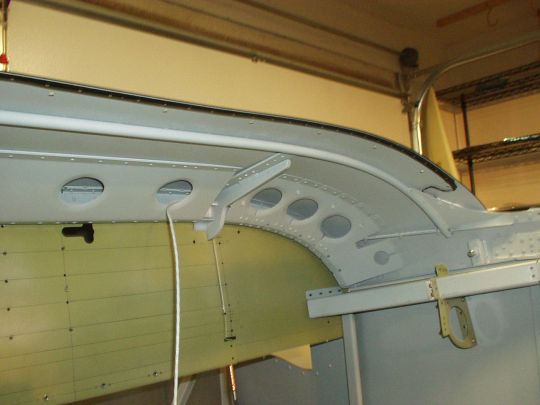|
  

Cockpit & Panel Lighting
Running Total Hours:
0.0
 | 2008.12.02:
(0.0) I decided to install an LED light strip under the glareshield
to provide panel lighting (and possibly cabin lighting, if I find it
sufficient by itself). There's a nice one that I've seen at Aircraft
Spruce's store front in Corona. After a little digging, I found that
this is imported from China by a little company called
Britta Products LLC, a.k.a. PilotLights.net, and is
sold by them directly as well as through
Spruce, Chief, SteinAir, and an EBay store. I ended up bying
mine from Spruce, partly for convenience of fast shipping and partly
because that's where I saw it first. But I had them match
Chief's price, which was substantially lower [sorry Chief, I'll buy
from you next time].
They sell these in several different single colors (red, blue, or
white), and also in dual-color versions (red and white or blue and
white). They claim that many commercial and military aircraft
now use blue lighting instead of red, although they didn't offer any
reason. If true, this is news to me, but it doesn't sound too
far fetched. I have very good day and night vision, but I've
always found red cockpit lighting to be fairly ineffective. It
just seems like it doesn't produce good contrast even on a black and
white approach chart, even at relatively high light levels. And
it's completely useless with printed color, such as a VFR chart.
When flying at night in the old spamcans I usually crank the white
instrument lights way up, and if that doesn't produce enough
illumination, I turn on my white headlamp on its lowest level.
White light at low levels doesn't seem to affect my night vision much,
and it lets me see much better inside the cockpit than red
light. So I know white light works for me, I know red light
doesn't, and I've never had the opportunity to try blue light.
So I opted for the dual color blue and white. This way, I'll
have to opportunity to try it both ways and decide what I like better.
Physically, there are 36 pairs of LEDs (one white and one blue), with
2.5 cm (~1") spacing between pairs. the LED strip is
encased in a flexible resin on a black backing, and is 90 cm
(~35") long by 1 cm (~3/8") wide and 1 mm thick. On
the backing is a double-sided tape for mounting. A bundle of 3
wires comes out on one end, and is secured (not very well) with some
kind of resin and heat-shrink tubing. Electrically, this is
designed for direct 12V operation, and is specified to consume 83mA
per color at 12V. They say it can be trimmed every 3 LEDs (or
every 3 pairs in case of the dual-color), so I presume the internal
circuit per color is 12 parallel circuits of 3 LEDs and a resistor in
series. Of the 3 wires, the black one is a common ground, and
the other two (both with white stripes) are the positive terminals of
the blue circuit and the white circuit.
Just thinking ahead, some form of dimming control will be
necessary. I'll probably use a PWM, but will have to ensure that
it doesn't generate any interference with the avionics.
Alternatively, I could use a linear current limiter. We'll see. |
 | 2009.02.19:
(0.0) The LED
strip comes with about 2 ft of wire, which is probably not long enough
for my installation. And anyway, the wire itself is of pretty
crappy quality, and consists of one two-conductor cable plus a
separate single conductor wire (dual colors were probably an
afterthought). Cheesey. So I decided to cut it off,
leaving only about a 4 inch pigtail, separate all three wires, twist
them, and then splice (well, solder actually) to a MIL-W-27500 22 AWG
shielded 3-conductor cable. The conductor assingments are as
follows:
1 (white): common ground
2 (blue): blue LED +12V power
3 (orange): white LED +12V power |
 | 2009.02.22:
(0.0) Installed
the LED strip under the glareshield.
Position: I decided to install it as far aft as possible, i.e. all the
way up to the aft edge of the glare shield skin. The reasons are
as follows:
1) To best illuminate the instrument panel. The further aft, the
better it will illuminate the instrument panel since that will
maximize luminous flux in the plane of the instrument panel, and also
minimize shadows cast by protruding objects (instruments, switches,
breakers, etc.) on the instrument panel.
2) To prevent the LEDs themselves from being in the pilot's view,
which would have a blinding effect. The padded glare shield trim
piece (not installed in the following photo) hangs down approximately
3/8" below the glare shield skin at the aft edge. So then
mounting the LED strip right up against it should do the trick.
I'll have to see once I have the seat cushions and can actually test
this. I have some concern that the most outboard sections of the
light strip might still be within the pilot's line of sight due to the
downward curvature of the glare shield. If that proves to be the
case, I may simply eliminate the offending sections of the LED strip
by covering it with black tape. We'll see.
 |

  
|
|